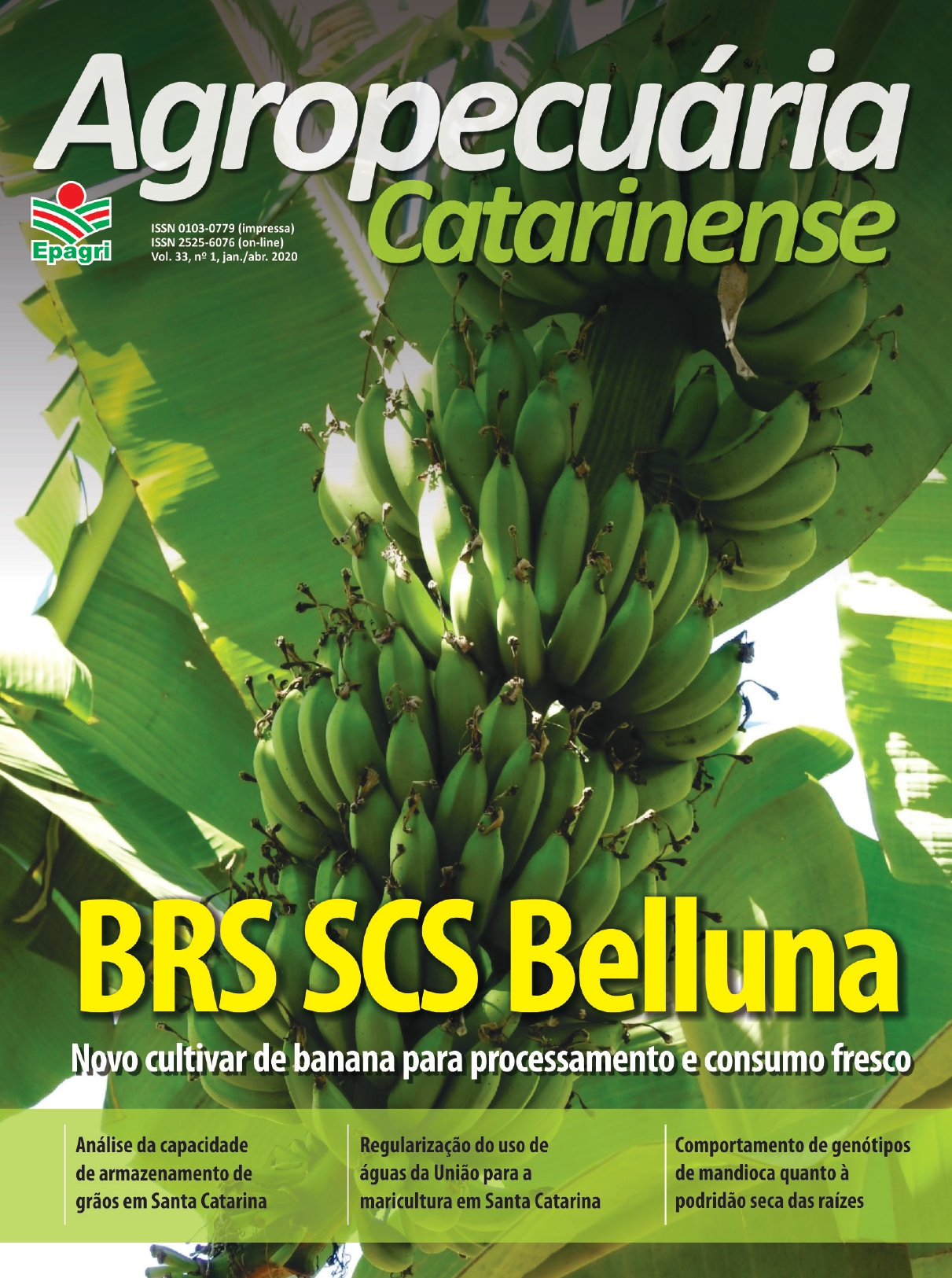Selection of cassava genotypes resistance to dry root rot
DOI:
https://doi.org/10.52945/rac.v33i1.498Keywords:
Fusarium solani, F. oxysporum, resistanceAbstract
Dry root rot is the most damaging disease of cassava (Manihot esculenta Crantz). Yield reduction caused by the disease range from 30% to 100%. This work aimed to assess cultivars and advanced clones from the cassava’s genetic breeding program of Epagri for resistance to dry root rot caused by Fusarium solani. A suspension of F. solani spores was inoculated on root discs of 21 cassava genotypes, in a concentration of 1.5 x 10 7 conidia mL-1 in four experiments. The disease severity was assessed through the percentage area colonized by the fungus. Stems of the more promising genotypes in resistance tests were selected for tests with F. solani in greenhouse. The cultivar Luna has potential to be used in F. solani infested areas and/or as progenitor for the breeding program, as it was the more resistant and presented high values of mass of aerial part and roots among the genotypes tested. Also the genotypes SC12-5035 and SC12-5029 showed potential for use in integrated
management of the disease.
Metrics
Publication Facts
Reviewer profiles N/A
Author statements
- Academic society
- Epagri - Revista Agropecuária Catarinense
- Publisher
- Empresa de Pesquisa Agropecuária e Extensão Rural de Santa Catarina - Epagri
References
ADISA, V.A. Surface mycoflora of Manihot esculenta and M. utilissima tubers in Nigeria. Indian Phytopathology, Nova Déli, v.36, p.533-538, 1983.
BANDYOPADHYAY, R.; MWANGI, M.; AIGBE, S. O.; LESLIE, J. F. Fusarium species from the cassava root rot complex in West Africa. Phytopathology, St. Paul, v.96, n.6, p.673-676, 2006.
BURGESS, L.W.; SUMMERELL, B.A.; BULLOCK, S.; GOTT, K.P.; BACKHOUSE, D. Laboratory manual for Fusarium research. Fusarium Research Laboratory. 3 ed. Sidney: Department of Crop Sciences, University of Sidney, 1994. 132p.
CHEARI, K.; SALLEH, B.; ZAKARIA, L. Fusarium virguliforme, a soybean sudden death syndrome fungus in Malaysian soil. Australasian Plant Disease Notes, v.9, p.1-7, 2014
EMBRAPA. Cultivo da mandioca para a região do cerrado. Sistemas de Produção. Jan. 2003. Disponível em: https://sistemasdeproducao.cnptia.embrapa.br/FontesHTML/Mandioca/mandioca_cerrados/doencas.htm. Acesso em: 22 mar. 2017.
MARSCHNER, H. Mineral Nutrition of Higher Plants. 2. ed. San Diego: Academic Press, 1995. 889p.
MUI-YUN, W. Fusarium oxysporum f. sp. lycopersici (Sacc.) W.C. Snyder and H.N. Hans. PP728 Soilborne Plant Pathogen Class Project. NC State University. 2003. Disponível em: https://projects.ncsu.edu/cals/course/pp728/Fusarium/Fusarium_oxysporum.htm. Acesso em: 21 fev. 2018.
O´DONNELL, K.; ROONEY, A.P.;PROCTOR, R.H.; BROWN, D.W.; McCORMICK, S.P.; WARD, T.J.; FRANDSEN, R.J.N.; LYSOE, E.; REHNER, S.A.; AOKI, T.; ROBERT, V.A.R.G.; CROUS, P.W.; GROENEWALD, J.Z.; KANG, S.; GEISER, D.M.
Phylogenetic analyses of RPB1 and RPB2 support a middle Cretaceous origin for a clade comprising all agriculturally and medically important fusaria. Fungal Genetics and Biology, v.52, p.20-31, 2013.
OLIVEIRA, E.J.; HOHENFELD, C.S.; SANTOS, V.S.; HADDAD, F. Resistance to Fusarium dry root rot disease in cassava accessions. Pesquisa Agropecuária Brasileira, Brasília, v.48, n.10, p.1414-1417, 2013.
ONYEKA, T.J., DIXON, A.G.O.; EKPO, E.J.A. Assessment of laboratory methods for evaluating cassava genotypes for resistance to root rot disease. Mycopathologia, v.159, p.461, 2005. DOI:http://dx.doi.org/10.1007/s11046-004-6156-z.
POLTRONIERI, L.S.; TRINDADE, D.R.; ALBUQUERQUE, F.C.; DUARTE, M.L.R.; CARDOSO, S.S. Incidência de Fusarium solani em mandioca no estado do Pará. Fitopatologia Brasileira, v.27, n.5, p.544, 2002.
SANTIAGO, C.H.; SANTANA, M.P.; CAIRO JUNIOR, L.R.; OLIVEIRA, S.A.S.; OLIVEIRA, E.J. Methodologies for selecting cassava with resistance to dry and black root rot under controlled conditions. Bragantia, v.77, n.3, p.440-451, 2018.
SHAW, D.E. Microorganisms in Papua New Guinea. Research Bulletin of the Department of Primary Industries Port Moresby, v.3, p.1-344, 1984.
SUMMERELL, B.A.; SALLEH, B.; LESLIE, J.F.






